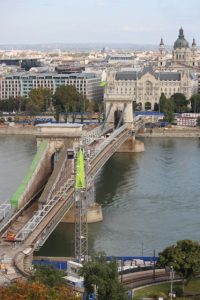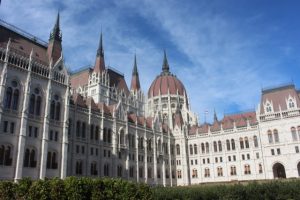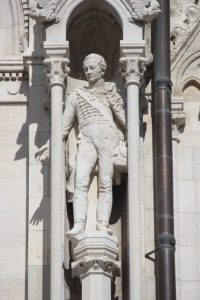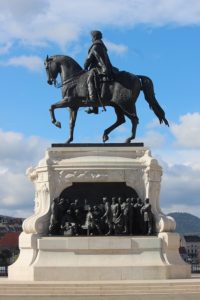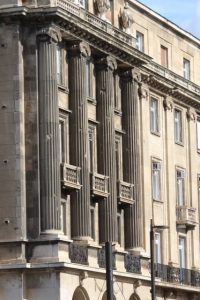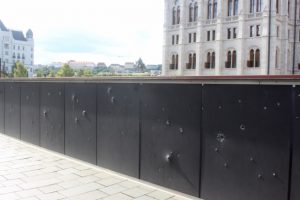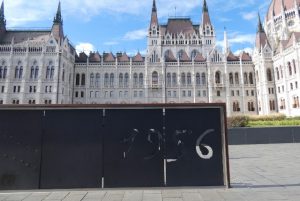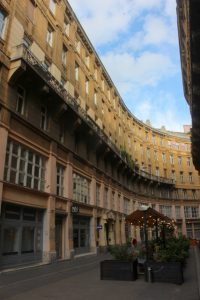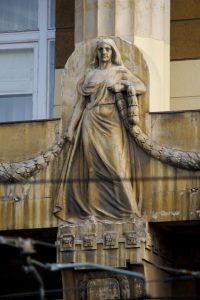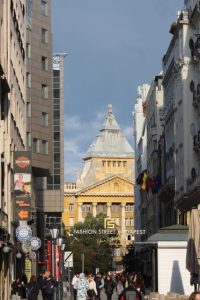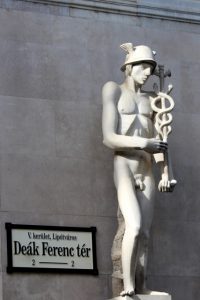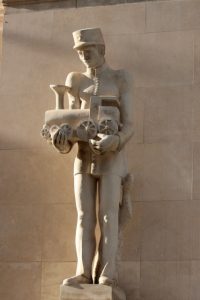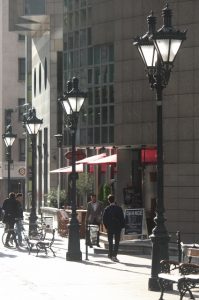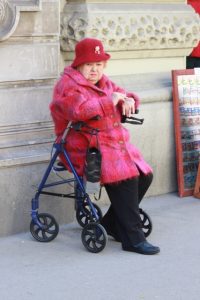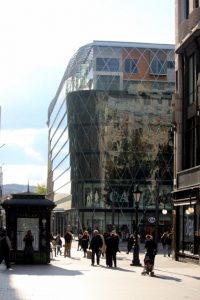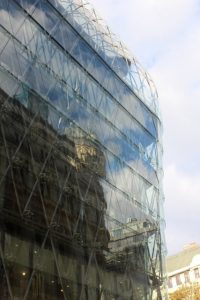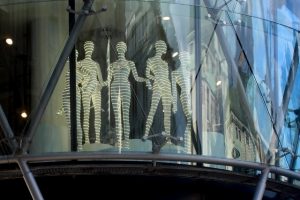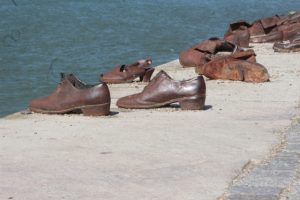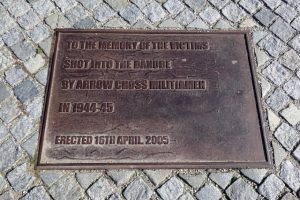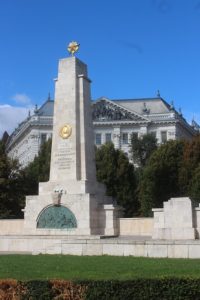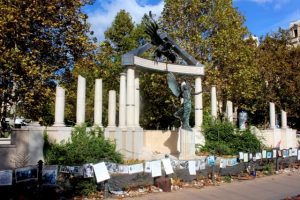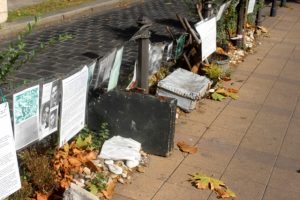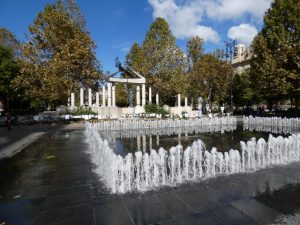
Anker Palota, or Anker Palace, in central Budapest is a great example of eclectic architecture in the city
Our first impression of Budapest is overwhelming, and not only because we haven’t see a big city for a while. It is the architecture and the memorials that excite us, at first.
We have to adjust somewhat. After several weeks in Slovakia and Eastern Hungary, dominated by rural environments and small town settings, Budapest is actually a big city again. Two million inhabitants – that’s 20% of the Hungarian population. Traffic congestion. People hurrying along the pavement. We are not used to this anymore.
I think everybody knows that Budapest is a merger of two cities, Buda and Pest, on either side of the Danube. There are multiple bridges across the river, and the metro has been dug under it, so plenty of opportunity to get to the other side. Our apartment being in Pest, we decide to explore Buda first. And cross by the most famous, and the oldest of all bridges, the Chain Bridge. Which is being refurbished, and thus closed. Of course. No worries, we’ll take the public ferry, which leaves from next to the bridge. Except, for reasons that remain unclear to us, today. Of course.
You know what? We’ll do Pest first. And it is not that there is not enough to do. The wide boulevards are lined with a whole range of buildings from different times and styles; the large squares are equally surrounded by monumental buildings. You don’t know where to look, really, and our progress is slow. Look here, that specific piece of decoration, or look there, that balcony, or door, or window. But it starts with individual buildings, too many to all show individually. I’ll attempt to highlight a few, starting with what has been called the eclectic architectural style – and, mind you, this is not going to be a complete summing up, just a small selection.
The most outspoken eclectic building is, no doubt, Parliament Building. It is huge, probably the biggest building in entire Budapest, located at the embankment of the Danube. Built between 1885 and 1902, it is a truly impressive structure, with a central cupola almost a hundred meters high, and lots of smaller and larger spires all around, Gothic-like if it wouldn’t be so white. It is well guarded, by not-so-secret police who swarm around the building, and by sculptures of statesmen of earlier times. Yet, you wonder why they need such a big building, given that the parliament now is a mere rubber stamp institute for the ruling political party, not unlike its role during communist party rule, or during the pre-war fascist rule.
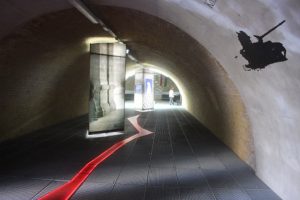
inside, underground, the memorial is a spine chilling collection of video and photo material, and testimonies of survivors
Of course, Kossuth square, right in front of the Parliament building, was also the place where the 1956 revolution played out, with ultimately the killing of demonstrators by Russian troops. I suspect the damage to buildings surrounding the square is due to bullet holes from that time; the entrance to the underground memorial to the uprising definitely suggests bullet holes in its fences. The memorial itself, with photo and video material of 1956, and testimonies of several survivors, is in a spine-chilling way perhaps even more impressive than the whole Parliament building.
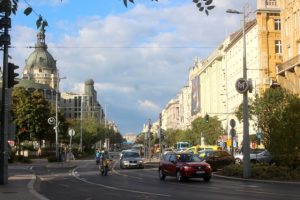
Deak Ferenc square, central Pest, with the Anker Palota the yellow building right, and on the left the Saint Stephen cathedral
Another striking example of eclectic building is the Anker Palota – the Anker Palace –, completed in 1910, for a Viennese insurance company. It is a seven-storey building, I believe in use as a hotel today, which is facing one of Budapest’s busiest squares, Deak Ferenc square. Behind its impressive front it is actually a triangular, free standing building, with an attractive little street, Anker Alley, running behind it.
There are more examples of eclectic architecture here.
Deak Ferenc square, and adjoining Erszebet Square (Elisabeth Square), form the heart of the city, from here all the main attractions are walkable distance. Towards the Danube one enters ‘Fashion Street’, in English, with at its far end a glass-and-metal commercial shopping complex. The contrast with the classical edifices like Anker Palota, the pseudo-old street lamps and what looks like 1930s (?) sculptures adorning other buildings in the street could not be bigger.
Talking about sculptures, Budapest has lots of them, large and small. But the most poignant is the iron ‘Shoes on the Danube Bank’ memorial for the around 3500 people, many of them Jews, who were shot at the edge of the river, after having been ordered to take off their shoes, in December 1944 and January 1945, by the fascist Arrow Cross party. The sculpturer, Gyula Pauer, created sixty pairs of shoes, abandoned, including women’s and children’s shoes. I have used the word spine-chilling already, but I do it here, once more.
In sharp contrast to this tasteful memorial are the many monuments put up in Szabadsag Ter, or Liberty Square. Most prominently present is the Soviet Memorial, for the liberation of Budapest by Soviet troops in 1945. Many want this removed, claiming that this was not a liberation after all, but the Hungarian government doesn’t wish to jeopardize its relations with Russia. To satisfy the non-communists post-1989, there is now a sculpture of Imre Nagy, the hero of the 1956 uprising, one of Ronald Reagan, and even a bust of admiral Miklos Horthy, Hungary’s controversial facist leader between the world wars – to satisfy the far right. And as if that is not enough, the present Fidesz government unveiled, in their self-declared Year of the Holocaust Remembrance, 2014, a monument with German eagle descending on the Archangel Gabriel, suggesting that Hungary had become in involuntary victim of Nazi Germany – not exactly as we remember history. Which thus has ignited a another protest, expressed by suitcases, plasticized photos and text claiming to really represent the Holocaust victims. And all of that on the same square (https://failedarchitecture.com/budapest-freedom-square/). The same square where a playful fountain innocently pumps its water in the air, and, depending on where bystanders are, leaving gaps in the wall of water. Everything goes, in an attempt to keep everybody somewhat happy.
Enough, for the moment. More about this fascinating city in Budapest (2).
